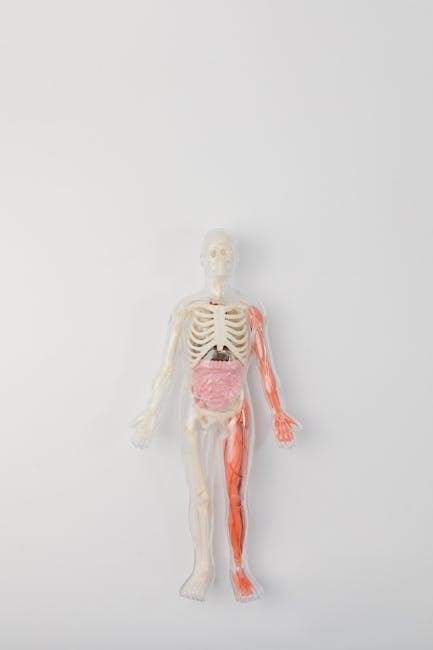7th grade math placement test pdf

The 7th Grade Math Placement Test assesses students’ math skills to determine their readiness for advanced courses‚ covering fractions‚ algebra‚ geometry‚ and data analysis to guide instruction effectively.
Overview of the Test Purpose
The 7th Grade Math Placement Test serves as a diagnostic tool to evaluate students’ math proficiency and readiness for advanced coursework. It covers content from Math 5/4‚ 6/5‚ 7/6‚ 8/7‚ and Algebra‚ ensuring a comprehensive assessment of skills. The test includes multiple-choice questions‚ short-answer problems‚ and constructed-response items‚ allowing for a detailed understanding of each student’s abilities. Its primary purpose is to identify whether students are prepared for the challenges of higher-level math courses. While not perfect‚ the test provides valuable insights to guide placement decisions and instructional strategies. Educators use the results to ensure students are appropriately challenged and supported in their academic journey.
Importance of Placement Tests for 7th Graders
Placement tests are crucial for 7th graders as they determine academic readiness and appropriate course placement. These assessments evaluate math skills‚ ensuring students are challenged yet supported. They cover various math levels‚ from earlier grades to algebra‚ providing a comprehensive skill gauge. By identifying strengths and weaknesses‚ teachers can tailor instruction‚ offering targeted support and enrichment. Students gain clarity on their abilities‚ reducing anxiety about advanced courses. While not perfect‚ these tests offer valuable insights‚ balancing expectations and guiding academic growth effectively. They help ensure students are well-prepared for their math education journey.

Structure and Format of the Test
The 7th Grade Math Placement Test is divided into two sessions with selected-response‚ short-answer‚ and constructed-response questions. It covers math topics from earlier grades to algebra‚ ensuring a comprehensive assessment of skills and readiness for advanced courses.
Test Length and Sections
The 7th Grade Math Placement Test is structured into two main sections‚ each designed to assess different aspects of a student’s mathematical proficiency. The first section typically contains 15 problems‚ focusing on foundational concepts such as whole numbers and basic fraction operations. This initial part is intended to be more straightforward‚ allowing students to ease into the test. The second section delves into more complex topics‚ incorporating a variety of question types‚ including multiple-choice‚ short-answer‚ and constructed-response questions. This diverse format ensures a comprehensive evaluation of skills across various math areas. The test’s length is considerable‚ as it covers a broad range of topics from earlier grades up to introductory algebra‚ making time management crucial for students to complete all sections effectively.
Types of Questions Included
The 7th Grade Math Placement Test incorporates a variety of question types to comprehensively assess mathematical skills. Multiple-choice questions are prevalent‚ offering students a structured format to demonstrate their understanding of key concepts. Short-answer questions require concise‚ precise responses‚ testing students’ ability to apply formulas and solve problems directly. Constructed-response questions are also included‚ allowing students to show their reasoning and problem-solving processes in detail. Additionally‚ word problems are integrated to evaluate real-world application skills. This mix of question types ensures that the test not only measures factual knowledge but also critical thinking and analytical abilities‚ providing a holistic view of each student’s mathematical competence.
Skills and Topics Covered
The 7th Grade Math Placement Test evaluates a wide range of mathematical skills and topics to ensure students are prepared for advanced coursework. Key areas include operations with fractions and decimals‚ such as simplifying expressions and performing multi-step calculations. Algebraic concepts‚ like solving equations and manipulating expressions‚ are also emphasized. Geometry topics cover perimeter‚ area‚ and volume calculations‚ as well as understanding basic shapes and their properties; Data analysis and probability questions assess students’ ability to interpret charts‚ graphs‚ and probability scenarios. Additionally‚ the test includes word problems that require applying mathematical concepts to real-world situations‚ ensuring students can think critically and solve problems effectively across various contexts.

Key Content Areas of the 7th Grade Math Test
The 7th Grade Math Test covers fractions‚ decimals‚ algebra‚ geometry‚ and data analysis‚ ensuring students apply mathematical concepts to solve real-world problems effectively.
Fractions and Decimal Operations
Fractions and decimal operations are foundational skills assessed in the 7th-grade math placement test. Students must demonstrate proficiency in simplifying complex fractions‚ adding‚ subtracting‚ multiplying‚ and dividing both fractions and decimals. The test includes problems involving mixed numbers‚ improper fractions‚ and converting between fractions and decimals. Word problems are also included to assess real-world application of these concepts. Mastery of these skills is essential for success in higher-level math courses‚ as they form the basis for algebra and advanced arithmetic. The test evaluates accuracy in calculations and the ability to apply these operations to solve practical problems effectively.
Algebraic Expressions and Equations
Algebraic expressions and equations are a critical component of the 7th-grade math placement test. Students are expected to simplify expressions by combining like terms and solving linear equations. Problems involve rewriting expressions using the distributive property‚ solving for variables‚ and graphing basic equations. The test also includes word problems that require setting up and solving equations to find unknown values. Skills such as identifying inverse operations and understanding the concept of equality are assessed. Students must demonstrate accuracy in solving equations like (2x + 3 = 10) and simplifying expressions like (3(4x ‒ 2)). Proficiency in algebraic manipulation is essential for advancing in math‚ making this section a key focus of the placement test.
Geometry and Measurement
Geometry and measurement are fundamental components of the 7th-grade math placement test. Students are assessed on their ability to calculate perimeter‚ area‚ and volume of various shapes‚ as well as convert units of measurement. Key topics include identifying properties of triangles‚ rectangles‚ and other polygons‚ and understanding angles and their measurements. The test also covers calculating surface areas and volumes of 3D figures‚ such as prisms and pyramids. Questions often involve applying these concepts to real-world problems‚ such as determining the distance between two points or the area of a room. Mastery of geometry and measurement is essential for advancing in math‚ as it builds a strong foundation for more complex spatial reasoning and problem-solving skills.
Data Analysis and Probability
Data analysis and probability questions on the 7th-grade math placement test evaluate students’ ability to interpret and draw conclusions from data; Topics include reading and creating bar graphs‚ histograms‚ and line plots‚ as well as understanding basic statistical measures like mean‚ median‚ and mode. Probability questions assess the likelihood of events‚ such as determining the chance of drawing a specific card or rolling a certain number on a die. Students are also expected to calculate probabilities of combined events and understand concepts like fairness and randomness. These skills are applied to real-world scenarios‚ helping students develop critical thinking and problem-solving abilities essential for advanced math studies.

Preparation Strategies for the Test
Effective preparation involves practicing with sample tests‚ reviewing key concepts‚ and improving time management skills to ensure readiness for the placement test format and content.
Using Practice Tests Effectively
Practice tests are a valuable tool for preparing for the 7th Grade Math Placement Test. They help students familiarize themselves with the test format‚ including the types of questions and time limits. By completing practice tests‚ students can identify areas where they need improvement and focus their study efforts accordingly. Many practice tests include multiple-choice questions‚ short-answer problems‚ and constructed-response items‚ mirroring the actual test structure. Regularly taking practice tests can improve problem-solving speed and reduce test anxiety. Additionally‚ reviewing mistakes after each practice test allows students to understand their errors and avoid repeating them. Consistent use of practice tests is key to building confidence and ensuring readiness for the actual placement test.
Studying Key Concepts and Formulas
Mastering key math concepts and formulas is essential for success on the 7th Grade Math Placement Test. Students should focus on understanding fractions‚ decimals‚ algebraic expressions‚ and geometry. Practicing operations with fractions‚ such as adding‚ subtracting‚ and multiplying‚ ensures proficiency. Memorizing algebraic formulas‚ like solving for variables in equations‚ is critical. Geometry topics‚ including calculating perimeters and areas‚ should be thoroughly reviewed. Data analysis and probability concepts‚ such as interpreting charts and calculating simple probabilities‚ are also important. Regularly reviewing these areas helps build a strong foundation. Applying concepts to real-world problems‚ like calculating averages or determining discounts‚ reinforces learning. Consistent practice with formulas and concepts ensures readiness for the test and future math courses.
Time Management Techniques
Effective time management is crucial for performing well on the 7th Grade Math Placement Test. Students should allocate a set amount of time to each question‚ ensuring they progress steadily through the test. Skimming through the entire test first to identify easier questions can help prioritize answers and optimize time use. For timed sections‚ practicing under similar constraints during preparation builds familiarity and reduces anxiety. Encouraging students to avoid spending too long on a single question and instead move forward‚ marking difficult ones for later review‚ maximizes their ability to complete the test. Regular practice with timed exercises helps improve speed and accuracy‚ ensuring they can confidently tackle all sections within the allotted time.

Scoring and Results Interpretation
The test’s scoring system evaluates student performance across various math topics‚ with results interpreted to determine readiness for advanced courses and guide academic placement decisions.
Understanding the Scoring System
The 7th Grade Math Placement Test uses a scoring system that evaluates student performance based on correct answers. The test includes multiple-choice‚ short-answer‚ and constructed-response questions‚ each scored differently. Multiple-choice questions typically award 1 point for correct answers‚ while short-answer and constructed-response questions may have varying point values based on complexity. The total raw score is converted to a scaled score‚ often ranging from 0 to 100‚ to ensure consistency across test administrations. Blank answers generally do not penalize students‚ while incorrect answers may deduct points depending on the test’s specific rules. Understanding the scoring system helps interpret results accurately and determine placement in appropriate math courses;
- Each question type has specific scoring rules.
- Scaled scores provide a clear measure of student performance.
- Blank answers typically do not affect the score negatively.
Interpreting Test Results
Interpreting the results of the 7th Grade Math Placement Test involves understanding the scoring scale and performance categories. Scores are often categorized into levels such as novice‚ proficient‚ advanced‚ or exemplary‚ indicating a student’s mastery of math concepts. Percentile rankings may also be provided to compare a student’s performance with peers. Higher scores typically indicate readiness for advanced math courses‚ while lower scores may suggest areas needing improvement. Schools use these results to place students in appropriate classes and provide targeted support. Parents and educators can review detailed reports to identify strengths and weaknesses‚ ensuring students receive the right academic challenges and interventions.
- Performance categories help define a student’s skill level.
- Percentile rankings offer a comparative measure of achievement.
- Results guide placement and instructional planning.
Using Results for Placement Decisions

The results of the 7th Grade Math Placement Test are instrumental in determining appropriate course placement for students. High scores may qualify students for advanced math classes‚ such as Algebra or Pre-Algebra‚ while lower scores might indicate the need for additional support or placement in a standard math course. Schools use these results to ensure students are challenged appropriately and to provide a foundation for future success. Placement decisions are often made in conjunction with teacher recommendations and prior academic performance. By aligning a student’s math skills with the right curriculum‚ educators can foster a more personalized and effective learning experience.

Resources for Test Preparation
Recommended study guides and online practice tests are essential for preparation. The Math Mammoth curriculum aligns perfectly with test content‚ ensuring comprehensive review and familiarity with the test format.
Recommended Study Guides

For effective preparation‚ the Math Mammoth Grade 7 Complete Curriculum is highly recommended‚ as it aligns closely with the test content. Additionally‚ practice tests from Nebraska and Missouri provide realistic question formats. The Free 7th Grade Math Practice Tests are also excellent for targeted practice‚ covering fractions‚ algebra‚ and geometry. These resources ensure students are well-prepared for the test format and content‚ helping them build confidence and familiarity with the material.
Online Practice Tests and Worksheets
Online practice tests and worksheets are invaluable tools for preparing for the 7th grade math placement test. Websites like Nebraska State Accountability Mathematics and Missouri Department of Elementary and Secondary Education offer free practice tests that mirror the actual exam format. These resources include multiple-choice questions‚ short-answer problems‚ and constructed-response tasks‚ covering topics such as fractions‚ algebra‚ and geometry. Additionally‚ platforms like Khan Academy and Mathway provide interactive exercises and worksheets to reinforce key concepts. Utilizing these online tools helps students familiarize themselves with the test structure‚ identify weaknesses‚ and improve problem-solving skills in a convenient and accessible way.
Math Mammoth Curriculum Alignment
The 7th Grade Math Placement Test is closely aligned with the Math Mammoth Grade 7 Complete Curriculum‚ ensuring a comprehensive assessment of math skills. This test covers topics such as fractions‚ decimals‚ algebraic expressions‚ and geometry‚ mirroring the curriculum’s structure. It is designed to evaluate a student’s mastery of key concepts taught in the Math Mammoth program‚ helping educators determine readiness for advanced math courses. While the test is not perfect‚ it provides valuable insights into a student’s understanding of the material. By aligning with the curriculum‚ it offers a reliable measure of progress and readiness for further math studies‚ making it a useful tool for placement decisions.

The Role of Placement Tests in Education
Placement tests play a crucial role in education by identifying students’ strengths‚ weaknesses‚ and readiness for advanced courses‚ ensuring proper placement and guiding personalized learning plans effectively.
Ensuring Readiness for Advanced Courses
The 7th Grade Math Placement Test evaluates students’ mastery of foundational concepts‚ ensuring they are prepared for more challenging material in advanced courses. By assessing skills in areas like fractions‚ algebra‚ and geometry‚ the test identifies whether students can handle higher-level math. This ensures proper placement‚ preventing gaps in understanding and fostering academic success. The test’s comprehensive design covers key topics‚ providing educators with insights to tailor instruction effectively. Accurate placement helps students build confidence and thrive in their math education journey‚ setting them up for long-term success in higher grades and future academic pursuits.
Identifying Strengths and Weaknesses
The 7th Grade Math Placement Test is designed to pinpoint students’ strengths and areas needing improvement in mathematics. By evaluating performance across key domains such as fractions‚ algebra‚ geometry‚ and data analysis‚ the test provides clear insights into individual capabilities. This detailed assessment helps educators understand where students excel and where additional support is required. For instance‚ if a student struggles with decimal operations but excels in geometric reasoning‚ targeted interventions can be developed. The test’s mix of multiple-choice and open-response questions ensures a comprehensive evaluation‚ offering a balanced view of each student’s mathematical proficiency. This information is crucial for tailoring instruction to meet individual needs and fostering overall academic growth.
Guiding Personalized Learning Plans
The 7th Grade Math Placement Test plays a pivotal role in shaping personalized learning plans by identifying specific skill levels and knowledge gaps. The test’s detailed results enable educators to tailor instruction to individual needs‚ ensuring each student receives targeted support. For example‚ if a student excels in algebra but struggles with fractions‚ the test highlights these areas‚ allowing for focused interventions. This data-driven approach helps create customized learning paths‚ setting clear goals and tracking progress. By aligning instruction with student strengths and weaknesses‚ the test supports a more effective and engaging learning experience‚ ultimately helping students build a strong foundation for future math courses.

Additional Tips for Success
Regular practice‚ seeking help when needed‚ and maintaining a positive mindset are key to excelling. Reviewing mistakes and using online resources can further enhance preparation and confidence levels significantly.
Reducing Test Anxiety
Reducing test anxiety is crucial for optimal performance. Students should practice relaxation techniques such as deep breathing or positive affirmations to calm their nerves. Ensuring thorough preparation by reviewing key concepts and using practice tests can build confidence. Time management during the test is also essential; skimming through questions first helps allocate time wisely and avoids panic. Encouraging a growth mindset and focusing on problem-solving rather than perfection can alleviate stress. Parents and educators should foster a supportive environment‚ emphasizing effort over results. By addressing anxiety proactively‚ students can approach the test with clarity and composure‚ allowing their knowledge and skills to shine.
Seeking Tutoring or Extra Help
Seeking tutoring or extra help is a proactive way to address math challenges. Students can benefit from one-on-one instruction tailored to their needs‚ helping them grasp difficult concepts. Online resources‚ such as tutoring platforms and educational websites‚ provide additional support. Many schools offer after-school programs or math centers where students can receive extra assistance. Encouraging students to ask questions in class and seek help early can prevent gaps in understanding. Parents can also hire private tutors or use math-focused study guides to reinforce learning. By accessing these resources‚ students can build confidence and improve their math skills effectively before taking the placement test.
Staying Motivated and Focused
Staying motivated and focused is crucial for success in the 7th grade math placement test. Encourage a growth mindset‚ emphasizing that effort and practice lead to improvement. Break study sessions into manageable chunks to avoid overwhelm and maintain concentration. Set realistic goals and celebrate small achievements to build confidence. Utilize positive reinforcement‚ such as rewarding progress‚ to keep motivation high. Create a dedicated study space free from distractions to enhance focus. Remind students of the importance of the test for future academic opportunities‚ helping them stay driven. Regular breaks and a balanced routine can also prevent burnout and keep energy levels steady. By maintaining a positive attitude and consistent effort‚ students can approach the test with confidence and determination.



Leave a Reply
You must be logged in to post a comment.